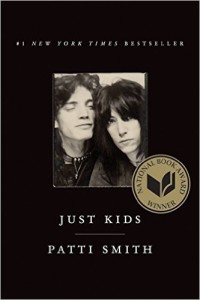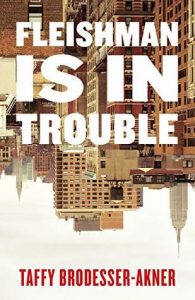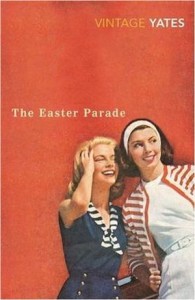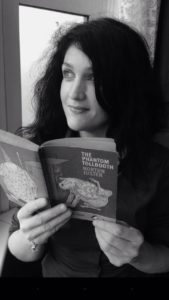
News by Julie
Books set in New York City
Having spent the better part of my 20s living in New York City, I have a huge soft spot for this iconic place. I crave books that bring back the noises, the buzz, the beauty, the people and the grittiness of the city. Here’s a selection of some of the very best ones.
 Just Kids by Patti Smith – Ever wondered what is was like to be a hip New York City artist in the late 1960s? Well, no need to wonder any longer, Patti Smith will take you right there in this fascinating autobiography. Just Kids is the story of rock and roll chick Patti Smith’s love affair and artistic collaboration with photography’s bad boy Robert Mapplethorpe, from their first chance meeting in a shop to his death-bed only two decades later. I there ever was a book to take you to New York City, this is it.
Just Kids by Patti Smith – Ever wondered what is was like to be a hip New York City artist in the late 1960s? Well, no need to wonder any longer, Patti Smith will take you right there in this fascinating autobiography. Just Kids is the story of rock and roll chick Patti Smith’s love affair and artistic collaboration with photography’s bad boy Robert Mapplethorpe, from their first chance meeting in a shop to his death-bed only two decades later. I there ever was a book to take you to New York City, this is it.
 A Little Life by Hanya Yanagihara – This is quite simply one of the most hauntingly beautiful books about friendship I have ever read. Yes, it is a devastatingly upsetting, dark and often traumatic read and it not without its flaws (at times overwritten and a bit repetitive). Set in New York City, it follows the life of four college friends navigating life post university. Yanagihara explores the idea of friendship enabling us to choose life over death; of friendship transforming terrible pain into intense joy. We all need to experience such friendships in our lives.
A Little Life by Hanya Yanagihara – This is quite simply one of the most hauntingly beautiful books about friendship I have ever read. Yes, it is a devastatingly upsetting, dark and often traumatic read and it not without its flaws (at times overwritten and a bit repetitive). Set in New York City, it follows the life of four college friends navigating life post university. Yanagihara explores the idea of friendship enabling us to choose life over death; of friendship transforming terrible pain into intense joy. We all need to experience such friendships in our lives.
 Dept. of Speculation by Jenny Offill – This little gem of a book was on The New York Times’ list of 10 best books of 2014, and with good reason. It’s an unusual novel, written in snapshots, in much the same fragmented way our memory works. It’s the sum of those memories that create the narrative of our past or, in this case, the story of a relationship. In Dept. of Speculation, Offill tells an age-old tale in a refreshingly new way and creates something truly different.
Dept. of Speculation by Jenny Offill – This little gem of a book was on The New York Times’ list of 10 best books of 2014, and with good reason. It’s an unusual novel, written in snapshots, in much the same fragmented way our memory works. It’s the sum of those memories that create the narrative of our past or, in this case, the story of a relationship. In Dept. of Speculation, Offill tells an age-old tale in a refreshingly new way and creates something truly different.
 Weather by Jenny Offill – Librarian Lizzie Benson lives a pretty ordinary life in New York City with her husband Ben and son Eli. What’s happening around her, however, is anything but. Climate change, Trump, threats to democracy, artificial intelligence, drug addiction – there’s plenty to worry about. How to absorb it all while going on living is the question. Weather by Jenny Offill puts words to what it’s like to live right now and thanks to her playful, fragmented writing style, this book is not nearly as depressing as it sounds.
Weather by Jenny Offill – Librarian Lizzie Benson lives a pretty ordinary life in New York City with her husband Ben and son Eli. What’s happening around her, however, is anything but. Climate change, Trump, threats to democracy, artificial intelligence, drug addiction – there’s plenty to worry about. How to absorb it all while going on living is the question. Weather by Jenny Offill puts words to what it’s like to live right now and thanks to her playful, fragmented writing style, this book is not nearly as depressing as it sounds.
 Golden Hill by Francis Spufford – New York, a small frontier town on the tip of Manhattan Island, 1746. One rainy autumn night, a mysterious, handsome stranger, fresh off the long Atlantic crossing from England, turns up at a counting house on Golden Hill Street in Manhattan. The enigmatic young man has a suspicious yet compelling proposition. From his pocket, he produces what seems to be a promissory note for a thousand pounds that he wishes to cash. An enormous sum of money in 1746, this bill has the power to shake the whole local economy as well as the political establishment. And, amiable and charming though Smith is, he won’t explain who he is or where he comes from, let alone what he is planning to do in the colonies that requires so much money.
Golden Hill by Francis Spufford – New York, a small frontier town on the tip of Manhattan Island, 1746. One rainy autumn night, a mysterious, handsome stranger, fresh off the long Atlantic crossing from England, turns up at a counting house on Golden Hill Street in Manhattan. The enigmatic young man has a suspicious yet compelling proposition. From his pocket, he produces what seems to be a promissory note for a thousand pounds that he wishes to cash. An enormous sum of money in 1746, this bill has the power to shake the whole local economy as well as the political establishment. And, amiable and charming though Smith is, he won’t explain who he is or where he comes from, let alone what he is planning to do in the colonies that requires so much money.
 The Bell Jar by Sylvia Plath – We begin in 1950’s New York, where Esther has won a month’s internship at a fashion magazine. As a gauche nineteen-year-old, she’s hoping that some of the city’s glamour will rub off on her, but is left feeling inexplicably empty and directionless. Knowing that many girls would envy her, Esther can’t understand why her heart is so numb. Failing to get onto a chosen writing course she faces the prospect of a suburban Boston summer with her uncomprehending mother and a calamitous slide into mental illness. Partially based on Plath’s own life, this 1963 classic retains its power to shock.
The Bell Jar by Sylvia Plath – We begin in 1950’s New York, where Esther has won a month’s internship at a fashion magazine. As a gauche nineteen-year-old, she’s hoping that some of the city’s glamour will rub off on her, but is left feeling inexplicably empty and directionless. Knowing that many girls would envy her, Esther can’t understand why her heart is so numb. Failing to get onto a chosen writing course she faces the prospect of a suburban Boston summer with her uncomprehending mother and a calamitous slide into mental illness. Partially based on Plath’s own life, this 1963 classic retains its power to shock.
 This is Pleasure by Mary Gatskill – Here’s one to set off a fiery debate around the dinner table. Now that the first storm around #MeToo has settled, This is Pleasure by Mary Gaitskill takes a step back and looks at the fallout. Quin, a successful, charming, New York based publisher, has been a huge flirt his entire adult life. While never explicitly abusing his power, Quin has always operated at the very edge of acceptable behaviour (sometimes overstepping it). It has now come back to haunt him. Many of us have had a Quin in our lives. What do we think of this one?
This is Pleasure by Mary Gatskill – Here’s one to set off a fiery debate around the dinner table. Now that the first storm around #MeToo has settled, This is Pleasure by Mary Gaitskill takes a step back and looks at the fallout. Quin, a successful, charming, New York based publisher, has been a huge flirt his entire adult life. While never explicitly abusing his power, Quin has always operated at the very edge of acceptable behaviour (sometimes overstepping it). It has now come back to haunt him. Many of us have had a Quin in our lives. What do we think of this one?
 Fleishman is in Trouble by Taffy Brodesser-Akner – Toby Fleishman is divorcing. He’s had enough of his absent, high-flying talent agent wife, Rachel, who never seems to be satisfied with his job as a doctor, their flat in Manhattan or indeed have time for their two kids. He’s fed up. In his new-found freedom he’s going through a sort of sexual renaissance. New York, it appears, is full of middle-aged horny women who will do anything to get laid by someone like Toby, or, actually, just anyone. Fleishman is in Trouble by Taffy Brodesser-Akner has descriptions of the befuddling world of online dating that had me, literally, screaming with laughter. But there’s more to this book than clever comedy and the turn to a more serious tone is both its strength and weakness.
Fleishman is in Trouble by Taffy Brodesser-Akner – Toby Fleishman is divorcing. He’s had enough of his absent, high-flying talent agent wife, Rachel, who never seems to be satisfied with his job as a doctor, their flat in Manhattan or indeed have time for their two kids. He’s fed up. In his new-found freedom he’s going through a sort of sexual renaissance. New York, it appears, is full of middle-aged horny women who will do anything to get laid by someone like Toby, or, actually, just anyone. Fleishman is in Trouble by Taffy Brodesser-Akner has descriptions of the befuddling world of online dating that had me, literally, screaming with laughter. But there’s more to this book than clever comedy and the turn to a more serious tone is both its strength and weakness.
 The Catcher in the Rye by J.D. Salinger – Holden Caulfield wants to tell us a little about his life, not his ‘whole goddam autobiography or anything,’ just the crazy stuff that happened to him the day he was kicked out of Pencey Prep School. We join Holden, surely one of literature’s great anti-heroes, on a mad and sad few days in New York City, as his troubled mind begins to unravel. Revisiting The Catcher in the Rye by J.D. Salinger seems most apt in this centenary year of his birth. Is there still a place for this once controversial novel in the hearts of today’s young readers?
The Catcher in the Rye by J.D. Salinger – Holden Caulfield wants to tell us a little about his life, not his ‘whole goddam autobiography or anything,’ just the crazy stuff that happened to him the day he was kicked out of Pencey Prep School. We join Holden, surely one of literature’s great anti-heroes, on a mad and sad few days in New York City, as his troubled mind begins to unravel. Revisiting The Catcher in the Rye by J.D. Salinger seems most apt in this centenary year of his birth. Is there still a place for this once controversial novel in the hearts of today’s young readers?
 The Easter Parade by Richard Yates – I often take refuge in the haven of mid-20th century American literature, a haven of superb, well-edited writing, of which The Easter Parade by Richard Yates is a good example. We’re in 1930’s New York. Sarah and Emily are sisters and the children of divorced parents Pookie and Walter Grimes. The opening sentence sets the stage: ‘Neither of the Grimes sisters would have a happy life, and looking back it always seemed that the trouble began with their parents’ divorce.’ Yates portrays family dysfunction and failure of communication and the striving to be something other than what you are. It all adds up to a potent reminder of how to NOT live your life.
The Easter Parade by Richard Yates – I often take refuge in the haven of mid-20th century American literature, a haven of superb, well-edited writing, of which The Easter Parade by Richard Yates is a good example. We’re in 1930’s New York. Sarah and Emily are sisters and the children of divorced parents Pookie and Walter Grimes. The opening sentence sets the stage: ‘Neither of the Grimes sisters would have a happy life, and looking back it always seemed that the trouble began with their parents’ divorce.’ Yates portrays family dysfunction and failure of communication and the striving to be something other than what you are. It all adds up to a potent reminder of how to NOT live your life.
 The Great Gatsby by F. Scott Fitzgerald – The rougher parts of New York City stand in stark contrast to the opulence of Long Island in Fitzgerald’s classic. Set in America in the 1920s, The Great Gatsby tells the story of self-made millionaire Jay Gatsby, his quest for acceptance by the snobbish, wealthy Long Island set and the love of his life: superficial, fickle Daisy. A social commentary on ‘Old’ versus ‘New’ money in America and the relentless pursuit of wealth, all seen through the eyes of the narrator, the outsider Nick Carraway. Wonderful atmosphere of the excesses and decadence of the roaring 1920s. A true gem; exceptionally well written and an iconic American novel.
The Great Gatsby by F. Scott Fitzgerald – The rougher parts of New York City stand in stark contrast to the opulence of Long Island in Fitzgerald’s classic. Set in America in the 1920s, The Great Gatsby tells the story of self-made millionaire Jay Gatsby, his quest for acceptance by the snobbish, wealthy Long Island set and the love of his life: superficial, fickle Daisy. A social commentary on ‘Old’ versus ‘New’ money in America and the relentless pursuit of wealth, all seen through the eyes of the narrator, the outsider Nick Carraway. Wonderful atmosphere of the excesses and decadence of the roaring 1920s. A true gem; exceptionally well written and an iconic American novel.




